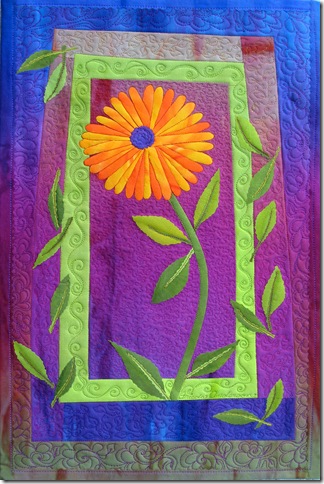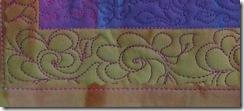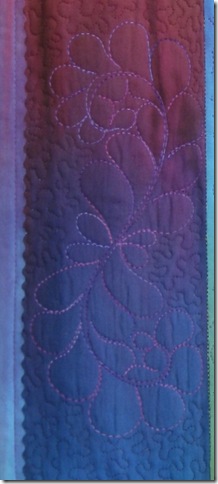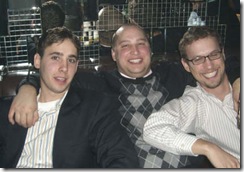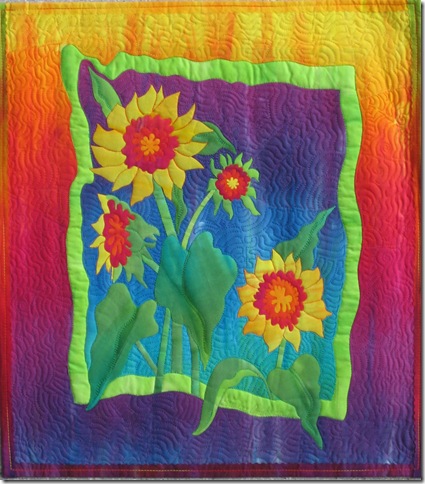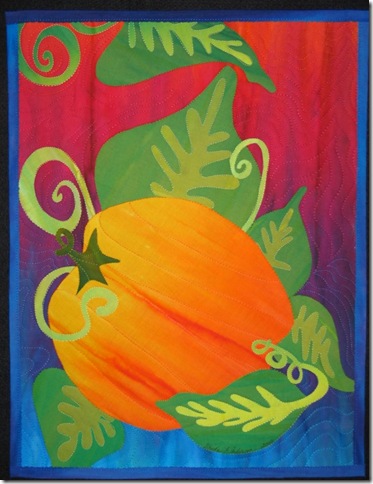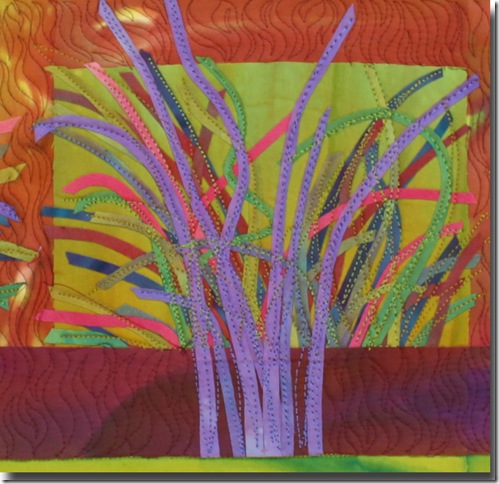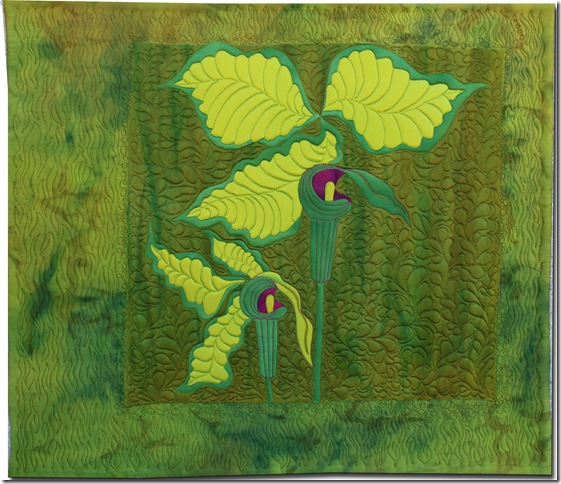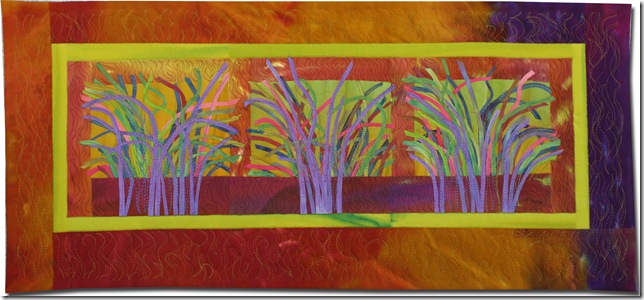Katie
Tuesday, July 27, 2010
Katie
Monday, July 26, 2010
San Jose
All meetings are held at:
1735 Saratoga Ave.
San Jose CA
(at Westgate Bible Church)
Click here for a map and directions.
This morning I went for a walk. Right away I passed under an orange tree with over ripe fruit laying all over the ground. A little later I passed by an Ebay campus. I wonder if it is THE Ebay campus. How we love Ebay. Only in California. The weather is beautiful and no bugs and NO humidity. Of course I did pass a couple of gas stations, and gas is $3.38 a gallon, oh oh.
Tuesday, July 20, 2010
More Fusing
Here are a few more thoughts and suggestions.
1. Make samples of things before you put them into a quilt. This seems like an obvious idea but so many people, me included sometimes, don’t take the time to do a test first. One of the things that we did in fashion design school was make samples of processes like button holes, welt pockets, and all kinds of finishes so that when we went to use them in a design we understood all the intricacies and mechanisms of the technique. Same goes for quilting.
2. If you are going to wash your quilt you will have to finish the edges of your design somehow. I have washed fused quilts and have been pleased that the fusible does not come undone, if I don’t want my edges to fray I need to zig-zag or satin stitch around them.
That being said I made a project for Quilting Arts TV two years ago that was intended to ravel when washed. It was a table runner made with fusible fabric and the decorative wavy blade. When it was washed all the edges frayed somewhat, it was part of the design.

Most of my quilts are art pieces. I never intend for them to be washed so I don’t satin stitch the edges. But I have begun playing around with the decorative stitches on my sewing machine and now some of my bigger pieces have different decorative stitches around the edges, more as a texture than a finish.
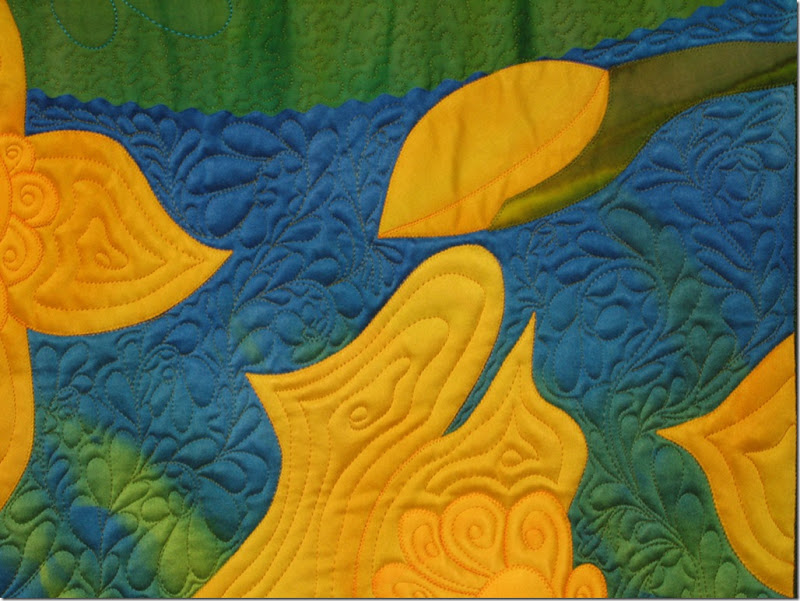 Detail of “Springs Greeting” with small zig zag around the edges and to add in detail on the flowers, done in matching silk thread.
Detail of “Springs Greeting” with small zig zag around the edges and to add in detail on the flowers, done in matching silk thread. 3. You can use all kinds of binding or finishing techniques even on larger quilts. I have done a pillow cased edge on a fused 48” square art quilt. I heavily machine quilted it. I had to make sure that I quilted it evenly all over because the quilting will make the quilt shrink up a bit and you want it to lay flat when you are finished.
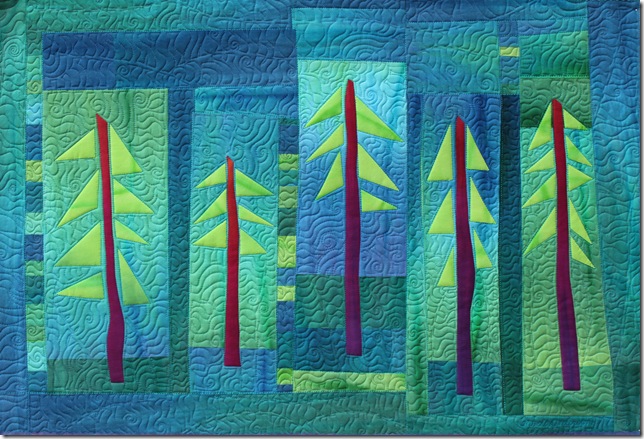
Duluth Trees 34” x 40”
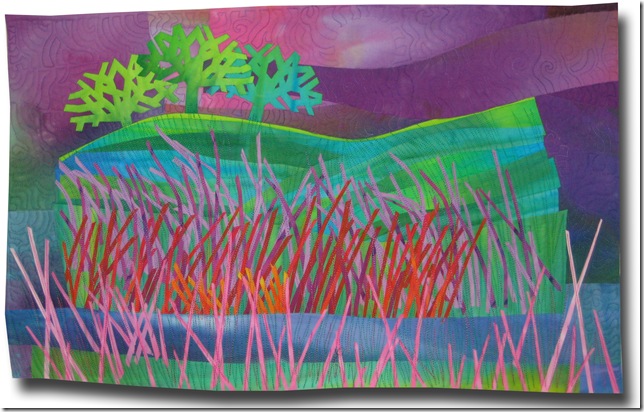
Beyond the Hill 30” x 20”
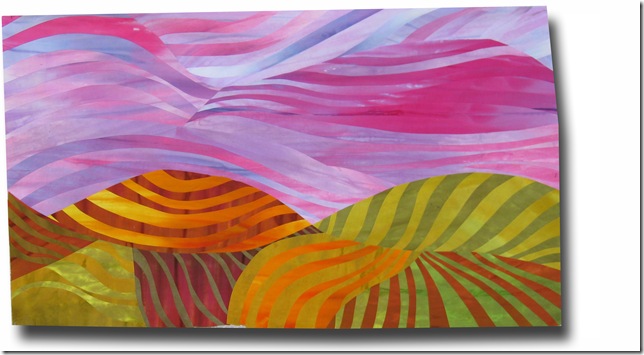
Illinois Landscape 42” x 24”
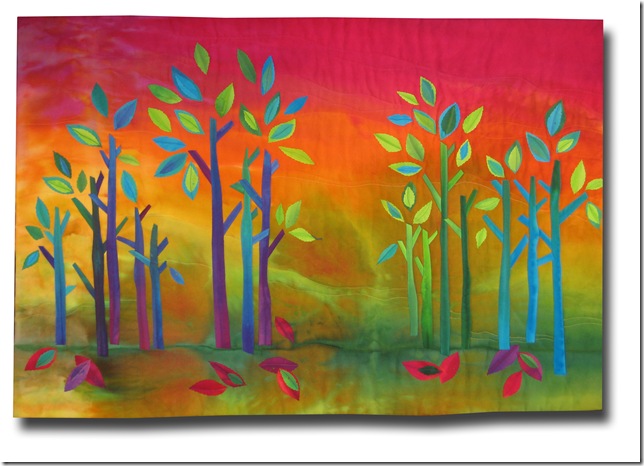
Enchanted Forest 42” x 24”
4. Assembly of a pillow cased quilt. (See Melody Johnson's escape hatch finish)
All of these four quilts are fused together on a piece of release paper, or a large pressing sheet. I have a large pressing sheet that is 40” x 60”. This sits on top of my design table. Once I have finished the design on the pressing sheet I steam set it on the sheet or release paper. It is then allowed to cool. Once it has cooled I lift it off of the sheet and fuse it to a piece of batting that has been steam pressed and allowed to cool. I then can “square up” my front and batting to any size and shape I like achieving some subtle curves on my edges.
The backing is then pillow cased on to the front of the quilt. I cut the backing fabric the exact same size as the front of the quilt and then I cut away 1/4” on two of the sides so that the back is slightly smaller than the front. This ensures that the front of the quilt will slightly roll to the back when it is turned right sides out and I won’t see any edges from the back on the front side of the quilt. When I sew the four sides I make sure that evenly distribute the backing fabric around the edge of the front fabric, easing in the smaller fabric on the back to the front. I sew all the way around all four edges and leave a slit in the top center of the backing fabric that has had fusible web applied to the inside with the fusible paper left on. I then turn it out through the slit in the backing fabric and once I have all of the edges ironed well I pull the paper off of the slit on the inside of the backing fabric and fuse it closed. After the quilt has been pillow cased I can then quilt it keeping in mind that the quilting is applied in an even manor.
Monday, July 19, 2010
Fusing
FUSING 101
The first thing you need to keep in mind is that fusible web is a heat activated product. When you place it on your fabric, usually the back side, you use your iron to apply it to the fabric.
1. You want your iron set to the cotton setting. It should be HOT and the steam is turned off. You don’t want to use steam when applying fusible web – EVER. I do use steam to set my fusible at the very end of a project when ALL of the quilting is done and the binding is in place.
2. You should apply it to fabric that has been prewashed if possible. Cotton, silk, rayon should all have any sizing removed this will allow the fusible to adhere to the fabric well.
3. Don’t over fuse the product. Read the directions on the package and do what it says to do. This is one of those cases where it pays to do what they tell you. You can’t get away with just looking at the pictures.
When ever possible I try to fuse my fabrics ahead of time and let them sit and cool down. If I am well organized I fuse them the day before. If not I try to fuse everything and then let them sit for a bit. Remember when you heat up the fusible web it gets sticky and melts and then when it cools down it solidifies again and sticks to the fabric.
I will go down in the studio in the morning and pick out my colors. I then fuse my fabrics and then I go eat breakfast or run an errand or do my exercises. When I am done they have completely cooled off and the release paper peels away very easily. DON’T over fuse them by using too much heat.
Do a few tests to see how it all works.
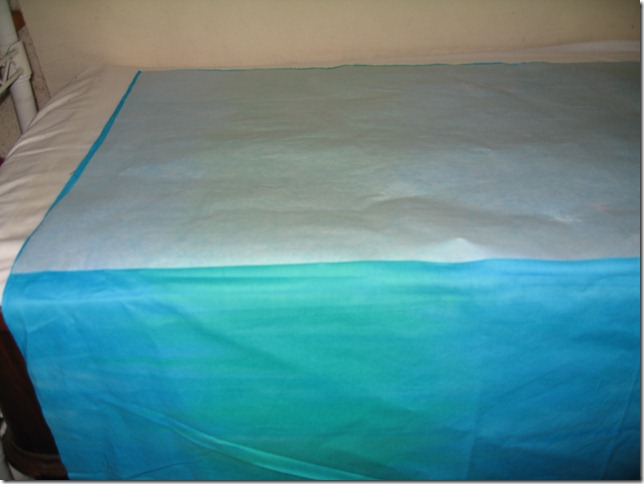
WonderUnder #805 on half of a yard of fabric. You can see the white “release” paper. It is sitting waiting to cool down before I remove the paper.
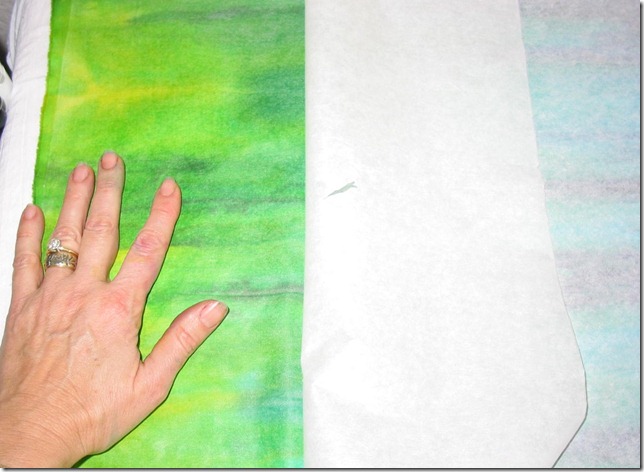
Using my hand to anchor one end of the fused fabric while I peel back the “release” paper. Notice how the fusible web on the fabric looks opaque. If is looks glassy you have fused it too long and will have to put another piece of fusible over it in order for it to still work.
Thursday, July 15, 2010
The process
I went through my sketchbook and found a very old sketch of trees. Probably done one day after our daily walk in the woods. I fooled around with it a bit and updated it and then redrew a cleaned up copy on release paper. It measures about 15” x 18”.
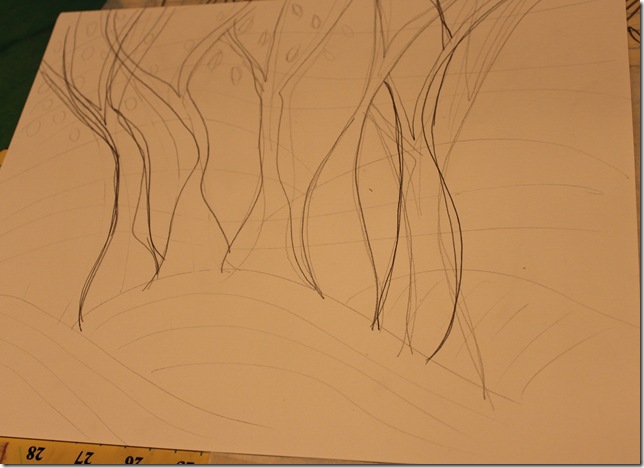
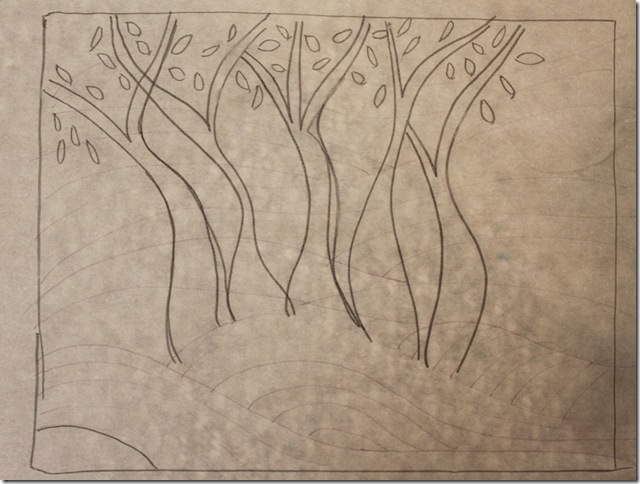
I then used another piece of parchment paper or release paper from the fused fabric and traced around base elements for a pattern. I used this pattern to cut out the green for the field and used my pinking blade rotary cutter to cut out strips for the fields. I assembled this on a different piece of release paper and built my fields and sky before adding in the trees and leaves. I used my wavy blade rotary cutter to cut long strips and then cut those strips apart to create the leaves.
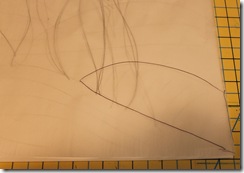
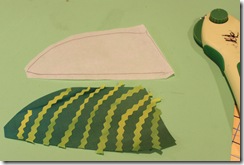
All of the fabric for this little landscape was pulled from my scrap drawers. I am on a big cleaning up and out kick this summer. Trying to rid myself of excess scraps and fabric. On that note my summer special on my website is to get a free fat quarter of fabric with any order over $20
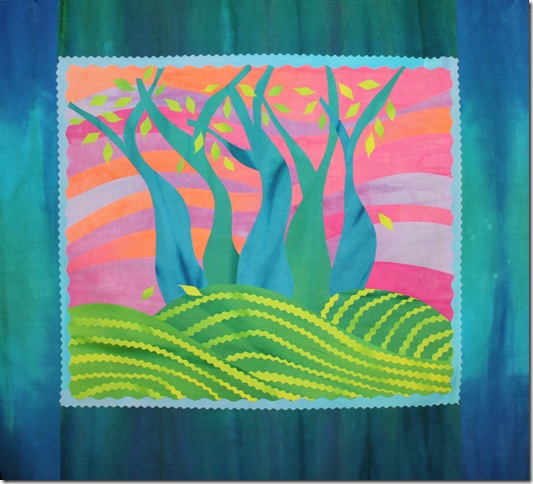
Not quilted yet so I will post again when it is.
Monday, July 12, 2010
Wisconsin Quilt Expo
I will be teaching this year at Wisconsin Quilt Expo. This is a great regional show and if you live close it is well worth the drive. Registration for classes has just opened today. You can go to the website and register on line.
I will also be teaching one of my favorite classes Blooming Fun.
Using just two different pieces of fabric every student will make their own version of this garden flower. We will be using my favorite decorative blade the “deckle blade” to create the leaves in this quilt.
If you ever wanted to take a Machine Quilting class I will be teaching it there. I have a whole new set of designs for you to learn in this fast fun really free motion machine quilting class. You can learn all the stitches I used to quilt Blooming Fun and many, many more.
 Swirly Curly and the ever popular
Swirly Curly and the ever popular
I hope I see you there.
Baby Boy
Today is my baby boy’s Birthday. Erik Charles is 25 years young. It seems impossible that this has happened. I am so proud of him. I am proud of all my men.
Erik Erik, Lars and Zachary
We just found out we are going to be grandparents!!! Baby Anderson is on it’s way. Lars and Megan are pregnant. How exciting. I will be grandma FeFe. I hope they don’t think I am a dog. Life is always changing and we are merrily dancing in the web of life.
We are in the web of life
Where our lifelines
Divide into thousands of parts
We are in the web of life
We can’t be quiet
Waiting for something more
Monday, July 5, 2010
Clearance
I am in a cleaning frenzy. On this 4th of July holiday I am cleaning my shelves and purging. Now until they are gone two of my favorite patterns are on SALE.
Petite Sunflower and Pumpkin are two of my very first patterns. My supply is dwindling and now is your chance to get a real bargain. While supplies last get these two patterns at a much reduced rate. These patterns would make excellent gifts for your quilting buddies are great first time projects for new quilters.
Petite Sunflower and Pumpkin are the perfect projects to work on your fusing skills. I know you will have fun making them and using them to decorate your home.
Sunday, July 4, 2010
Raw edge fusing
Jackie asked:Okay, when you put fabric on your background, do you do hand appliqué, because I can't see any bare threads hanging out as you might in fusing.
Dear Jackie,
98% of my work is all RAW edged fused. The rest is machine appliquéd or machine pieced. ALL of my small work is raw edged fused using wonder under #805 pellon fusible. It is my preferred fusible. I believe there are several reasons why there are no visible bare threads hanging on my art pieces.
- I use only my own hand dyed fabrics or batiks, therefore there are no white edges showing on my work.
- I use only fabric that has been washed multiple times to remove all starches or sizing from the fabric. By doing this my fusible sticks very well to the fabric. This is KEY.
- I only cut out my designs after the “release paper” has been removed. This eliminates the need to pull the paper off the cut design which would cause the edge to fray.
- I almost always do outline stitch in the ditch around my design elements. Although when I am using a decorative blade to cut out my design element I usually can not do stitch in the ditch. And in the case of the grass or weeds in “Prairie Grass” I cut all the long grass pieces on the bias again eliminating fraying on the edges.
Saturday, July 3, 2010
Friday, July 2, 2010
Machine quilting
Sally wrote and asked the following;
Hi. I love your two new pieces on your blog. I was looking at your quilting, especially the "flame" look stitching. I just finished a quilt that used that type of quilting in part of it and when I turned the quilt over I noticed there were tiny "blobs" of thread at the point of many of the flames. Am I making any sense? Do you get those, and if not, how do you avoid them? And what kind of machine do you use? BTW, I always look forward to seeing what's new on your blog. TIA, Sally
Thanks for asking Sally. Without seeing your work my guess would be that you are pausing when you get to the tip of the flame. If you pause while you are quilting in one spot you will create little knots on the back, this is because you are taking more than one stitch in that spot. It is possible that your tension is off a bit as well. You can tighten or loosen the upper tension and see if that helps. One of the things I try to do before beginning to quilt any thing is do a test run on a scrap quilt sandwich. I keep these under my sewing area so that I can just grab one and go. I want to check my tension with what ever thread I have put in the top and the bottom of my machine. I can then make adjustments before I start on my piece.
When I am creating a design I make sure I can use it smoothly. I want to be able to just change direction as I am quilting. So I practice it before I begin to use it in my work. I use those scrap sandwiches to practice, practice, practice so that my quilting is crisp and the flow is smooth. As I make that flame design when I reach the top of flame I just change direction to where I want to go next. I may slow down but I never take extra stitches at the point. That is why practice is so important. 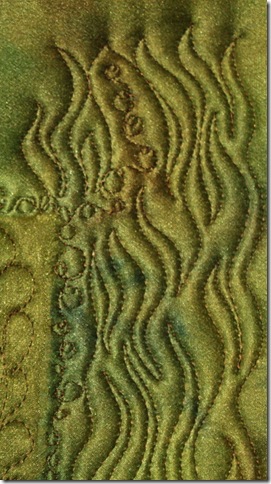
 No matter what design you are making, you want your points to be sharp. So get out those sandwiches and practice!
No matter what design you are making, you want your points to be sharp. So get out those sandwiches and practice!
I have a Janome 6600 that I love. This is my third Janome and I have been very happy with all of them. They have a new model out a 7700QCP Horizon. I think if I was in the market for a new machine I would look at this one. But I think it is important to deal with a dealer that is close to where you live so if you don’t have a Janome dealer near you visit the dealer you have and test drive the machines. A great place to try out all the new models is a quilt show. I bought my second Janome at one of the big quilt shows and they usually have some nice discounts.
Hope this all helps.




